Discover 35 hidden attractions, cool sights, and unusual things to do in Detroit (United States). Don't miss out on these must-see attractions: Detroit Institute of Arts, Renaissance Center, and Detroit Zoo. Also, be sure to include Comerica Park in your itinerary.
Below, you can find the list of the most amazing places you should visit in Detroit (Michigan).
Table of Contents
Detroit Institute of Arts
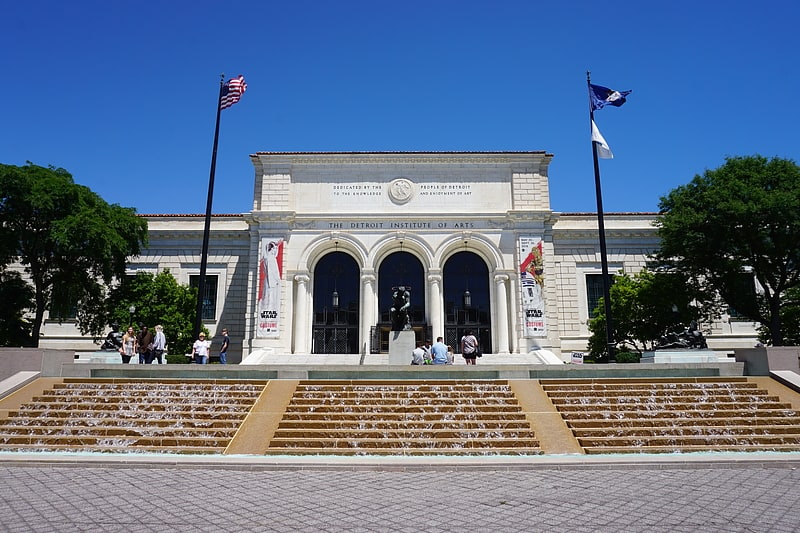
Large art museum displaying global works. The Detroit Institute of Arts, located in Midtown Detroit, Michigan, has one of the largest and most significant art collections in the United States. With over 100 galleries, it covers 658,000 square feet with a major renovation and expansion project completed in 2007 that added 58,000 square feet. The DIA collection is regarded as among the top six museums in the United States with an encyclopedic collection which spans the globe from ancient Egyptian and European works to contemporary art. Its art collection is valued in billions of dollars, up to $8.1 billion according to a 2014 appraisal. The DIA campus is located in Detroit's Cultural Center Historic District, about two miles north of the downtown area, across from the Detroit Public Library near Wayne State University.
The museum building is highly regarded by architects. The original building, designed by Paul Philippe Cret, is flanked by north and south wings with the white marble as the main exterior material for the entire structure. The campus is part of the city's Cultural Center Historic District listed in the National Register of Historic Places. The museum's first painting was donated in 1883 and its collection consists of over 65,000 works. With about 677,500 visitors annually for 2015, the DIA is among the most visited art museums in the world. The Detroit Institute of Arts hosts major art exhibitions; it contains a 1,150-seat theatre designed by architect C. Howard Crane, a 380-seat hall for recitals and lectures, an art reference library, and a conservation services laboratory.[1]
Address: 5200 Woodward Ave, 48202 Detroit (Cass Corridor)
Renaissance Center
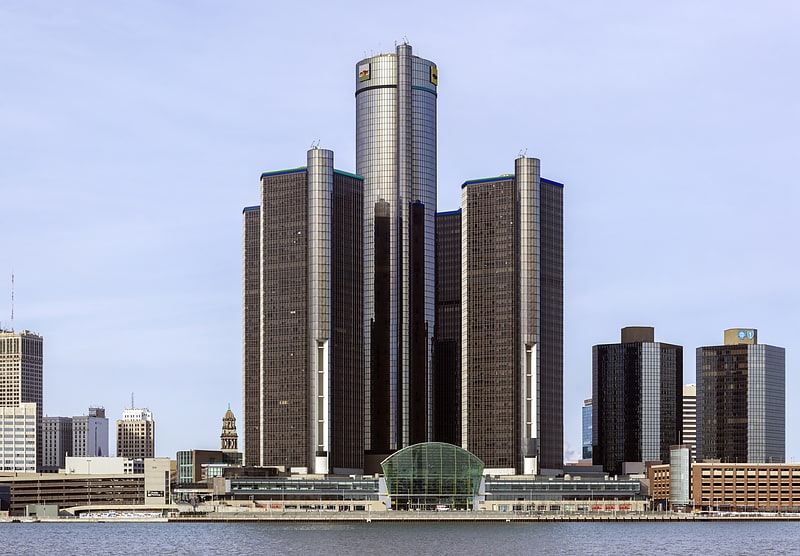
Shopping complex with GM headquarters. The Renaissance Center is a group of seven connected skyscrapers in Downtown Detroit, Michigan, United States. The Renaissance Center complex is on the Detroit International Riverfront and is owned by General Motors as its world headquarters. The central tower has been the tallest building in Michigan since it was erected in 1977.
John Portman was the principal architect for the original design. The first phase consisted of a five-tower rosette rising from a common base. Four 39-story office towers surround the 73-story hotel rising from a square podium which includes a shopping center, restaurants, brokers, and banks. The first phase officially opened in March 1977. Portman's design brought renewed attention to city architecture, since it resulted in construction of the world's tallest hotel at the time. Two additional 21-story office towers (known as Tower 500 and Tower 600) opened in 1981. This type of complex has been termed a city within a city.
In 2004, General Motors completed a US$500 million renovation of the Class-A center as its world headquarters, which it had purchased in 1996. The renovation included the addition of the five-story Wintergarden atrium, which provides access to the International Riverfront. Architects for the renovation included Skidmore, Owings & Merrill, Gensler, SmithGroup, and Ghafari Associates. Work continued in and around the complex until 2005. Renaissance Center totals 5,552,000 square feet (515,800 m2) making it one of the world's largest commercial complexes.
In July 2015, the complex was re-branded as "The GMRENCEN." Its logo was modernized and "Reflecting a New Detroit" was introduced as the new tagline. A photo-journalistic advertising campaign launched to "shine a spotlight on the people in Detroit who make remarkable contributions" to the city.
Despite the name, the hotel portion is not affiliated with the Renaissance Hotels chain, also owned by Marriott. An unrelated Renaissance Hotel does exist in the suburb of Novi however.[2]
Address: 400 Renaissance Dr W, 48243 Detroit
Detroit Zoo

Popular zoo with acclaimed polar bears. The Detroit Zoo aka Detroit Zoological Park is a zoo located in Royal Oak and Huntington Woods, Michigan, about 2 miles north of the Detroit city limits, at the intersection of Woodward Avenue, 10 Mile Road, and Interstate 696. It is operated by the Detroit Zoological Society, a non-profit organization, along with the Belle Isle Nature Center, located within the city limits of Detroit on Belle Isle. The Detroit Zoo is one of Michigan's largest family attractions, hosting more than 1.5 million visitors annually. Situated on 125 acres of naturalistic exhibits, it is home to more than 2,400 animals representing 235 species. The Detroit Zoo was the first zoo in the United States to use barless exhibits extensively.[3]
Address: 8450 West 10 Mile Road, Detroit
Comerica Park
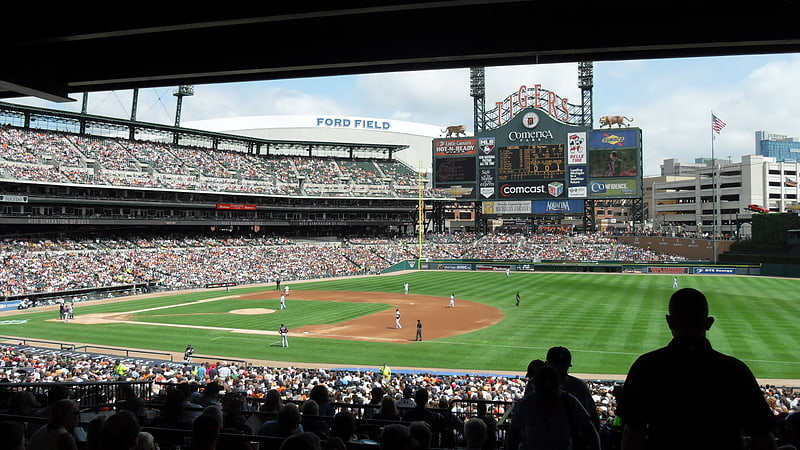
Quirky ballpark with large food court. Comerica Park is a baseball stadium located in Downtown Detroit. It has been the home of Major League Baseball's Detroit Tigers since 2000, when the team left Tiger Stadium.
The stadium's seating capacity is 41,083.[4]
Address: Detroit, 2100 Woodward Avenue
Guardian Building
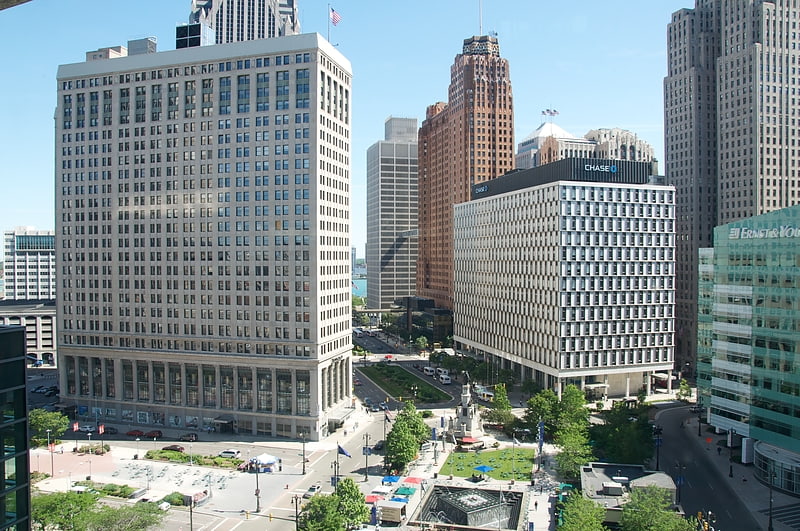
Landmark art deco skyscraper with shops. The Guardian Building is a landmark skyscraper in the United States, located at 500 Griswold Street in Downtown Detroit, Michigan, within the Financial District. The Guardian is a class-A office building owned by Wayne County, Michigan and serves as its headquarters. Built in 1928 and finished in 1929, the building was originally called the Union Trust Building and is a bold example of Art Deco architecture, including art moderne designs. At the top of the Guardian Building's spire is a large U.S. flag, complementing the four smaller flags atop nearby 150 West Jefferson. The building has undergone recent award-winning renovations. It was designated a National Historic Landmark on June 29, 1989, and the associated Detroit Financial District is on the National Register of Historic Places. The Guardian building includes retail and a tourist gift shop.[5]
Address: 500 Griswold St, 48226-3480 Detroit
Chene Park
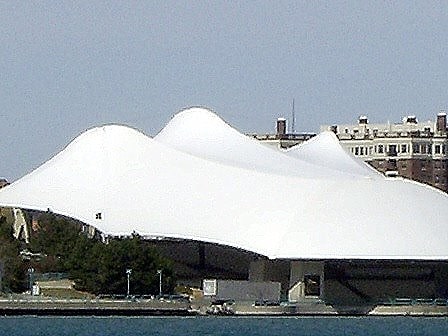
The Detroit International Riverfront is a tourist attraction and landmark of Detroit, Michigan extending from the Ambassador Bridge in the west to Belle Isle in the east, for a total of 5.5 miles. The International Riverfront encompasses a cruise ship passenger terminal and dock, a marina, a multitude of parks, restaurants, retail shops, skyscrapers, and high rise residential areas along with TCF Center. The Marriott at the Renaissance Center and the Robert's Riverwalk Hotel are also situated along the International Riverfront. Private companies and foundations together with the city, state, and federal government have contributed several hundred million dollars toward the riverfront development. Key public spaces in the International Riverfront, such as the RiverWalk, Dequindre Cut Greenway and Trail, William G. Milliken State Park and Harbor, and a cruise ship passenger terminal and dock at Hart Plaza complement the architecture of the area. The area provides a venue for a variety of annual events and festivals including the Detroit Electronic Music Festival, Detroit Free Press International Marathon, the Detroit International Jazz Festival, Motor City Pride, the North American International Auto Show, River Days and Detroit China Festival. In February 2021, the Detroit International Riverfront was voted best riverwalk in the United States by USA Today readers.[6]
Address: 2600 Atwater St, 48207-4418 Detroit
Ford Piquette Avenue Plant
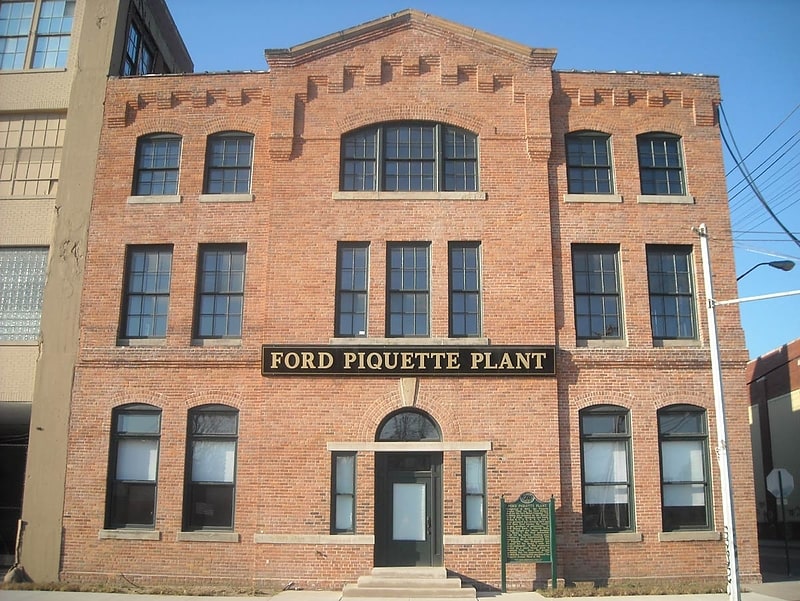
Factory in Detroit, Michigan. The Ford Piquette Avenue Plant is a former factory located within the Milwaukee Junction area of Detroit, Michigan, in the United States. Built in 1904, it was the second center of automobile production for the Ford Motor Company, after the Ford Mack Avenue Plant. At the Piquette Avenue Plant, the company created and first produced the Ford Model T, the car credited with initiating the mass use of automobiles in the United States. Prior to the Model T, several other car models were assembled at the factory. Early experiments using a moving assembly line to make cars were also conducted there. It was also the first factory where more than 100 cars were assembled in one day. While it was headquartered at the Piquette Avenue Plant, Ford Motor Company became the biggest U.S.-based automaker, and it would remain so until the mid-1920s. The factory was used by the company until 1910, when its car production activity was relocated to the new, bigger Highland Park Ford Plant.
Studebaker bought the factory in 1911, using it to assemble cars until 1933. The building was sold in 1936, going through a series of owners for the rest of the 20th century before becoming a museum in 2001. The Piquette Avenue Plant is the oldest purpose-built automotive factory building open to the public. The museum, which was visited by over 31,000 people in 2018, has exhibits that primarily focus on the beginning of the United States automotive industry. The building was added to the National Register of Historic Places in 2002, became a Michigan State Historic Site in 2003, and was designated a National Historic Landmark in 2006.[7]
Address: 461 Piquette St, 48202-3547 Detroit (Cass Corridor)
Little Caesars Arena
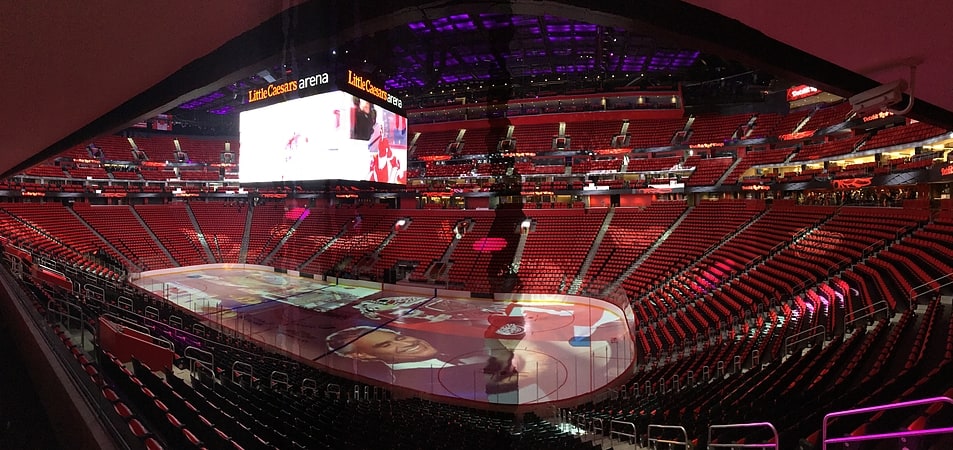
Arena in Detroit, Michigan. Little Caesars Arena is a multi-purpose arena in Midtown Detroit. Construction began on April 24, 2015, following a formal groundbreaking ceremony on September 25, 2014. Opened on September 5, 2017, the arena, which cost $862.9 million to construct, replaced Joe Louis Arena and The Palace of Auburn Hills as the home of the Detroit Red Wings of the National Hockey League and the Detroit Pistons of the National Basketball Association, respectively.
The arena features a unique, clear plastic roofed concourse connecting it to offices and shops surrounding it. It was designed to be the flagship of a new $2.1 billion 650,000-square-foot (60,000 m2) sports and entertainment district, The District Detroit, with mixed-use neighborhoods with new residential and retail outlets located around the Cass Corridor, Ford Field, and Comerica Park.[8]
Address: Detroit, 2645 Woodward Avenue
James Scott Memorial Fountain
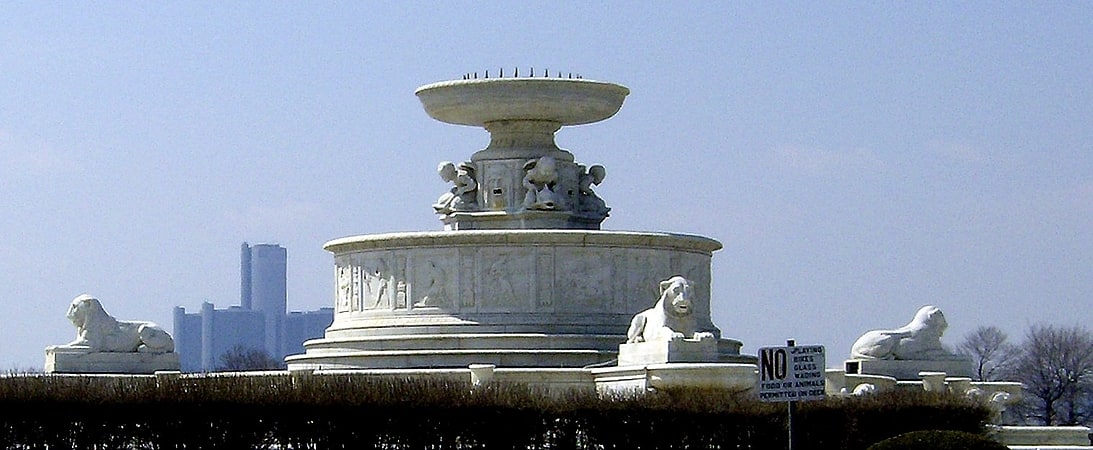
Fountain in Detroit, Michigan. The James Scott Memorial Fountain is a monument located in Belle Isle Park, in Detroit, Michigan. Designed by architect Cass Gilbert and sculptor Herbert Adams, the fountain was completed in 1925 at a cost of $500,000. The lower bowl has a diameter of 510 ft and the central spray reaches 125 ft. The fountain honors the controversial James Scott, who left $200,000 to the City of Detroit for a fountain in tribute to himself.[9]
Address: Fountain Way, 48207 Detroit
Campus Martius Park

City park in Detroit, Michigan. Campus Martius Park is a re-established park in Downtown Detroit, Michigan. After the fire of 1805, Campus Martius was the focal point of Judge Augustus Woodward's plans to rebuild the city. It was named for the principal square in Marietta, Ohio, the first capital of the Northwest Territories.[10]
Address: 800 Woodward Ave, 48226-3580 Detroit
Fox Theatre
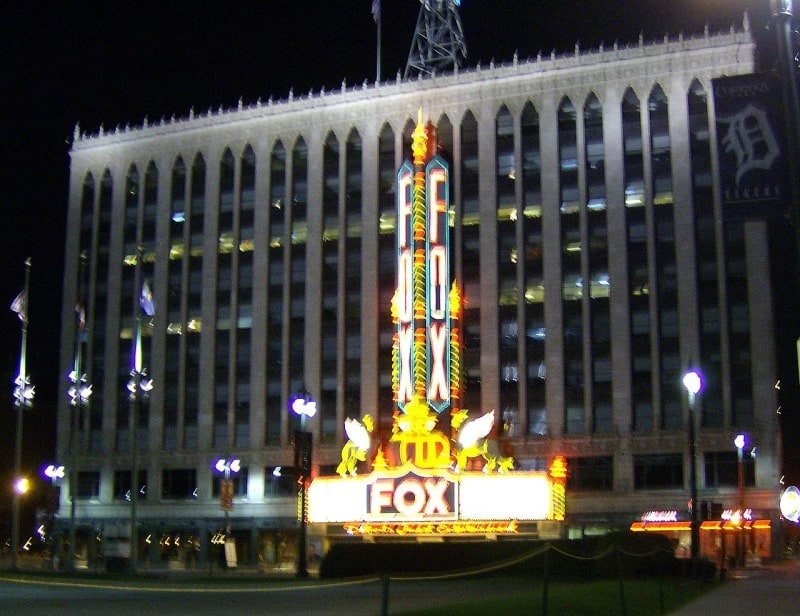
Performing arts center in Detroit, Michigan. The Fox Theatre is a performing arts center located at 2211 Woodward Avenue in Downtown Detroit, Michigan, near the Grand Circus Park Historic District. Opened in 1928 as a flagship movie palace in the Fox Theatres chain, it was at over 5,000 seats the largest theater in the city. Designed by theater architect C. Howard Crane, it was listed on the National Register of Historic Places in 1985 and was designated a National Historic Landmark in 1989 for its architecture. The area surrounding the Fox is nicknamed Foxtown. The city's major performance centers and theatres emanate from the Fox Theatre and Grand Circus Park Historic District and continue along Woodward Avenue toward the Fisher Theatre in the city's New Center.
The Fox has 5,048 seats (5,174 seats if removable seats placed in the raised orchestra pit are included). It is the largest surviving movie palace of the 1920s and the largest of the original Fox Theatres. The Fox was fully restored in 1988. The adjacent office building houses the headquarters of Olympia Entertainment and Little Caesars.[11]
Address: Detroit, 2211 Woodward Avenue
Ambassador Bridge
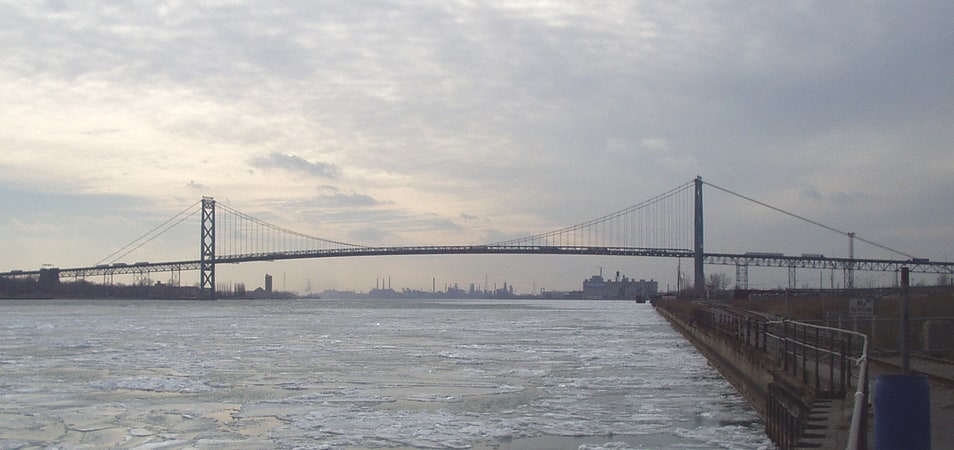
Long span linking the U.S. and Canada. The Ambassador Bridge is a tolled, international suspension bridge across the Detroit River that connects Detroit, Michigan, United States, with Windsor, Ontario, Canada. Opened in 1929, it is the busiest international border crossing in North America in terms of trade volume, carrying more than 25% of all merchandise trade between the United States and Canada by value. A 2004 Border Transportation Partnership study showed that 150,000 jobs in the Detroit–Windsor region and US$13 billion in annual production depend on the Detroit–Windsor international border crossing.
The bridge is one of the few privately owned US–Canada crossings; it was owned by Grosse Pointe billionaire Manuel Moroun, until his death in July 2020, through the Detroit International Bridge Company in the United States and the Canadian Transit Company in Canada. In 1979, when the previous owners put it on the New York Stock Exchange and shares were traded, Moroun was able to buy shares, eventually acquiring the bridge. The bridge carries 60 to 70 percent of commercial truck traffic in the region. Moroun also owned the Ammex Detroit duty free stores at both the bridge and the tunnel.[12]
Hart Plaza
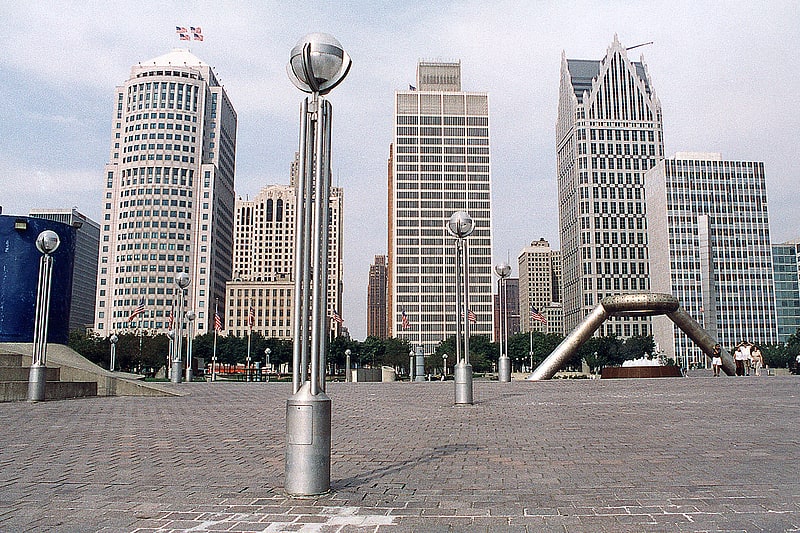
Event venue in Detroit, Michigan. Philip A. Hart Plaza, in downtown Detroit, is a city plaza along the Detroit River. It is located more or less on the site at which Antoine Laumet de La Mothe, sieur de Cadillac landed in 1701 when he founded Fort Pontchartrain du Détroit, the settlement that became Detroit. In 2011, the Detroit-Wayne County Port Authority opened its new cruise ship passenger terminal and dock at Hart Plaza, adjacent to the Renaissance Center, which receives major cruise ships such as the MS Hamburg and the Yorktown.
The 14-acre plaza, which is named for the late U.S. Senator Philip Hart, opened in 1975 and has a capacity for about 40,000 people. At the center of the plaza is the Horace E. Dodge and Son Memorial Fountain, designed by Isamu Noguchi and Walter Budd in 1978.[13]
Address: 1 Hart Plz, 48226-4344 Detroit
Motown Museum

History of the famous label and hit-maker. "Hitsville U.S.A." is the nickname given to Motown's first headquarters and recording studio. The house is located at 2648 West Grand Boulevard in Detroit, Michigan, near the New Center area. The house was purchased by Motown founder Berry Gordy in 1959.
After purchasing the house, Gordy converted it for use as the record label's administrative building and recording studio. Following mainstream success in the mid 1960s through mid 1970s, Gordy moved the label to Los Angeles and established the Hitsville West studio there, as a part of his focus on television and film production as well as music production.
Today, the “Hitsville U.S.A” property operates as the Motown Museum, which is dedicated to the legacy of the record label, its artists, and its music. The museum occupies the original house and an adjacent former residence.[14]
Address: 2648 W Grand Blvd, 48208 Detroit (Rosa Parks)
MotorCity Casino Hotel
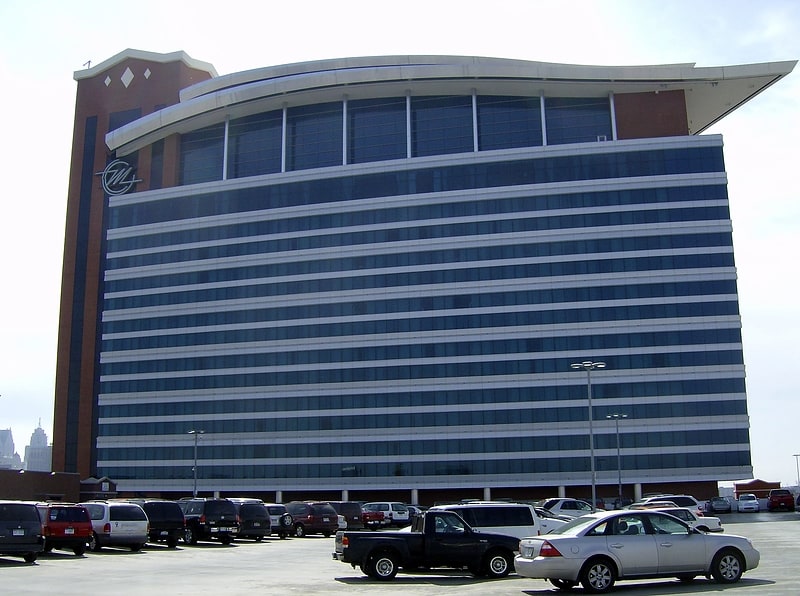
Casino in Detroit, Michigan. MotorCity Casino Hotel is a casino and hotel in Detroit, Michigan. It opened in December 1999 and is one of three casino hotels in the city. There are four in the Detroit–Windsor area, including the Ontario-owned Caesars Windsor.
The $825 million MotorCity complex incorporates a historic building that once housed the Wagner Baking Company, makers of the brand Wonder Bread. The complex houses a 100,000 square-foot casino with approximately 2,800 slot machines, 59 table games, and two poker rooms; a 13,000-square-foot spa; 67,000 square feet of meeting and convention space; Sound Board, a live music theater with a capacity of 2,400 people; and a luxury hotel with 400 guest rooms and suites.
Opened by Mandalay Resort Group, MotorCity Casino Hotel was later purchased by Marian Ilitch of IH Gaming (Detroit Entertainment, LLC).[15]
Address: Detroit, 2901 Grand River Avenue, Detroit, Michigan 48201
Fisher Building
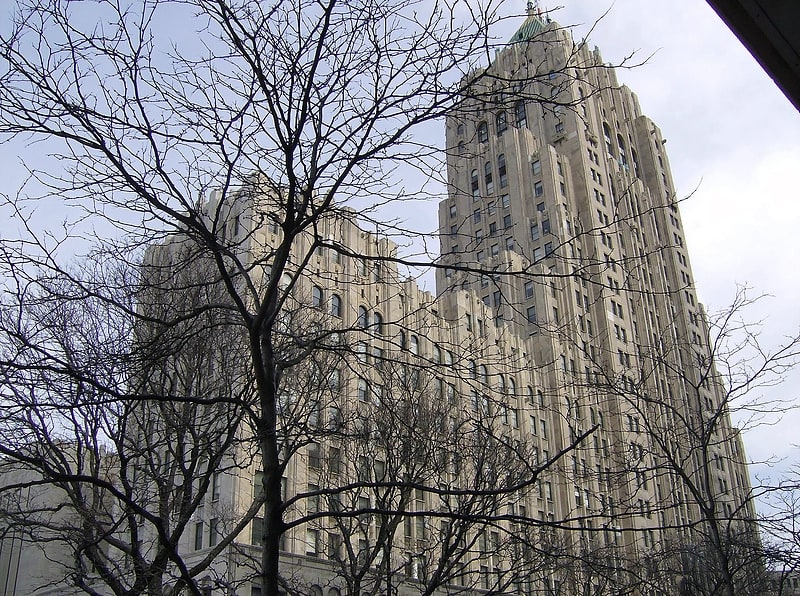
Ornate art deco landmark with a theater. The Fisher Building is a landmark skyscraper located at 3011 West Grand Boulevard in the heart of the New Center area of Detroit, Michigan. The ornate 30-story building, completed in 1928, is one of the major works of architect Albert Kahn, and is designed in an Art Deco style, faced with limestone, granite, and several types of marble. The Fisher family financed the building with proceeds from the sale of Fisher Body to General Motors. It was designed to house office and retail space.
The building, which contains the elaborate 2,089-seat Fisher Theatre, was designated a National Historic Landmark on June 29, 1989. It also houses the headquarters for the Detroit Public Schools and the studios of radio stations WJR, WDVD, and WDRQ.[16]
Address: 3011 W Grand Blvd, 48202-3096 Detroit (Cass Corridor)
Greektown Casino
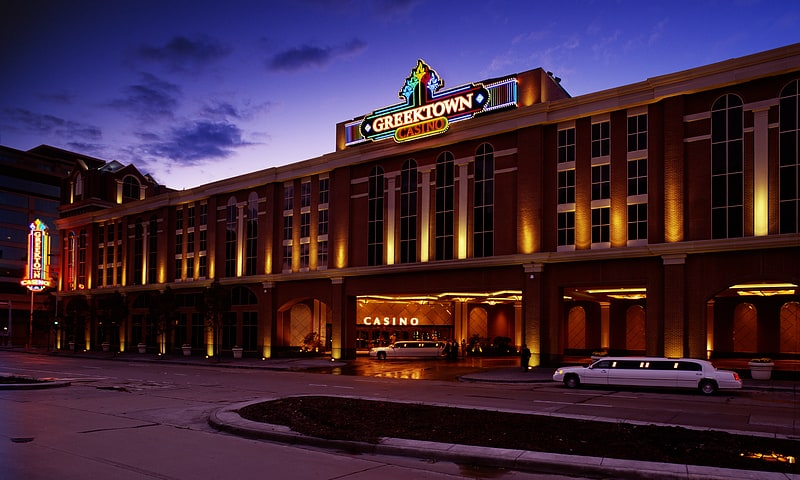
Casino in Detroit, Michigan. Greektown Casino-Hotel in Detroit, Michigan is one of three casino resort hotels in the city; there is a nearby casino in Windsor, Ontario, in Canada, at the other end of the tunnel connecting the two cities. When this casino opened in 2000 in the Greektown Historic District, the federally recognized Sault Ste. Marie Tribe of Chippewa Indians held a majority interest. It was the only gaming casino in Detroit to be controlled by a Native American tribe.
In 2008, during the Great Recession, the tribe filed for bankruptcy protection for the casino and sold its interest in the property. Since 2019, the property has been owned by Vici Properties and operated by Penn National Gaming. Detroit is one of the largest American cities and metropolitan regions to offer casino resort hotels.[17]
Address: 555 E Lafayette Blvd, 48226-2924 Detroit
Grand Circus Park
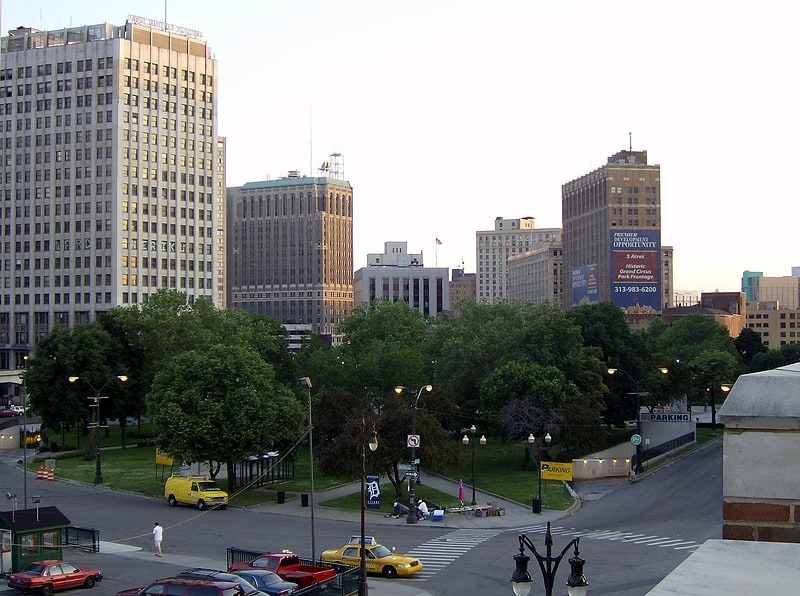
City park in Detroit, Michigan. The Grand Circus Park Historic District contains the 5-acre Grand Circus Park in Downtown Detroit, Michigan that connects the theatre district with its financial district. It is bisected by Woodward Avenue, four blocks north of Campus Martius Park, and is roughly bounded by Clifford, John R. and Adams Streets. The district was listed on the National Register of Historic Places in 1983. The building at 25 West Elizabeth Street was added to the district in 2000, and additional structures located within the district, but built between 1932 and 1960, were approved for inclusion in 2012.[18]
Address: 1883 Woodward Ave, Detroit
Kunsthalle Detroit
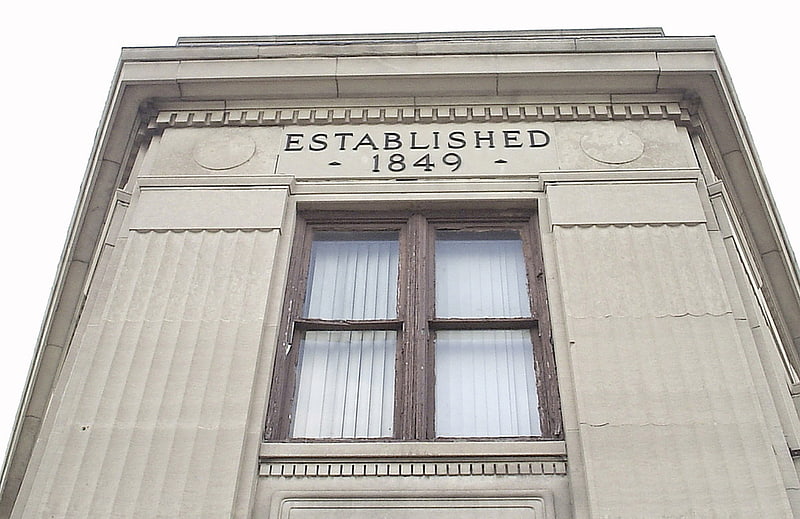
Art institute in Detroit, Michigan. Kunsthalle Detroit is a non-profit 501 art institution that is focused on contemporary visual art that uses light as a medium. The institution was formed in 2009 in Detroit, Michigan by Tate Osten, who has stated that she chose light art because it shows how the 21st century has progressed with technology. Artist Tim White-Sobieski came up with the name for the institution and is meant to emulate European kunsthallen. The German word "kunsthalle" was also used to provide for wide and international access to the Midwest's "most blighted city" as to the new, fruitful grounds for arts and cultural development. The founders also proposed a plan for a Light Biennale called "Luminale Detroit". The plan eventually scaled down to a weekend of light artworks under the name "Delectricity". NewNowNext has credited Kunsthalle Detroit as being "one of only a few of its kind in the world". Kunsthalle Detroit is privately funded.
Kunsthalle Detroit was initially located in a building on Grand River Avenue in Detroit, however this building was later sold in 2015 to a local entrepreneur.
Kunsthalle Detroit is a 501(c)(3) non profit arts museum. Eleven years after its founding, Kunsthalle Detroit reopens in 2020 at its new location - 8200 Gratiot Ave. Detroit MI 48213.[19]
St. Joseph Oratory
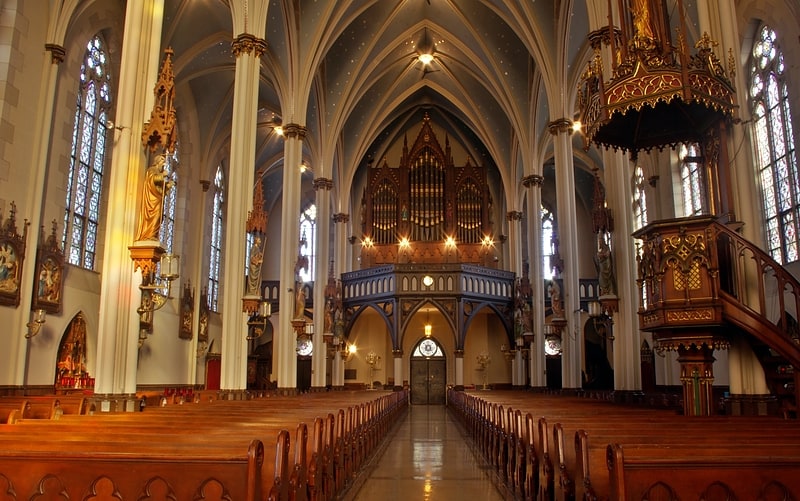
Catholic church in Detroit, Michigan. St. Joseph Shrine, founded in 1855, is a historic German Catholic church located at 1828 Jay Street in the Eastern Market–Lafayette Park neighborhood area just outside downtown Detroit, Michigan, on the city's central east side. The building was listed on the National Register of Historic Places in 1972, and deemed "of national importance" because of its stained glass. Three subsidiary buildings—the rectory, convent, and the Wermers House—were added to the listing in 1992. It is a parish of the Archdiocese of Detroit, and presently a shrine dedicated to the celebration of the pre-Vatican II liturgy under the care of the canons of the Institute of Christ the King Sovereign Priest.[20]
Fort Wayne

Building in Detroit, Michigan. Fort Wayne is located in the city of Detroit, Michigan, at the foot of Livernois Avenue in the Delray neighborhood. The fort is situated on the Detroit River at a point where it is under half a mile to the Ontario shore. The original 1848 limestone barracks still stands, as does the 1845 fort. On the grounds but outside the original fort are additional barracks, officers quarters, hospital, shops, a recreation building, commissary, guard house, garage, and stables.
The fort sits on 96 acres (39 ha). Since the 1970s, 83 acres (34 ha), including the original fort and a number of buildings, has been operated by the city of Detroit. The remaining area is operated by the U.S. Army Corps of Engineers as a boatyard. The fort was designated a Michigan State Historic Site in 1958 and listed on the National Register of Historic Places in 1971.[21]
Address: 6235 W Jefferson Ave, 48209 Detroit (Vernor)
Detroit Opera House
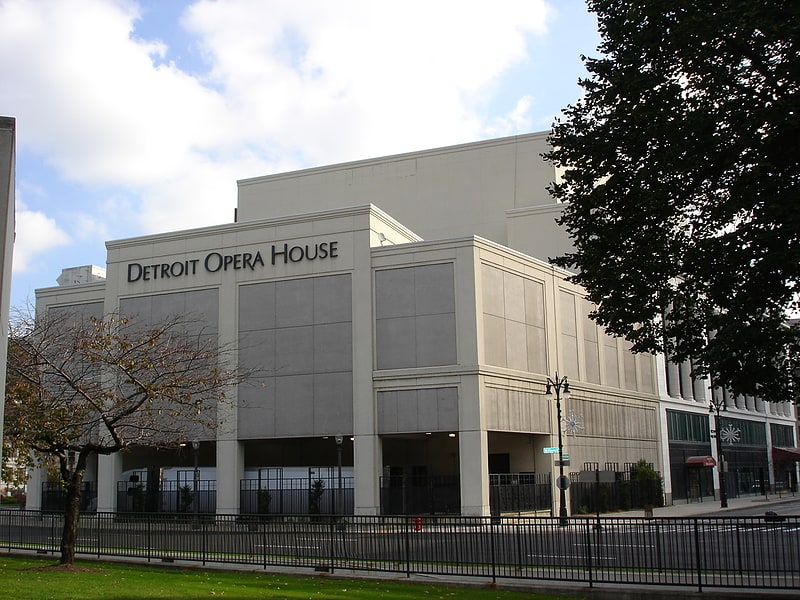
Theatre in Detroit, Michigan. The Detroit Opera House is an ornate opera house located at 1526 Broadway Street in Downtown Detroit, Michigan, within the Grand Circus Park Historic District. The 2,700-seat venue is the home of productions of the Michigan Opera Theatre and a variety of other events. The theatre was originally designed by C. Howard Crane, who created other prominent theatres in Detroit including The Fillmore Detroit, the Fox Theater and the Detroit Symphony's Orchestra Hall. It opened on January 22, 1922.
The building underwent an extensive restoration which took place under the control of Detroit-based architectural design firm, Albert Kahn Associates, Inc. It reopened in 1996.[22]
Address: 1526 Broadway St, 48226-2196 Detroit
Charles H. Wright Museum of African American History
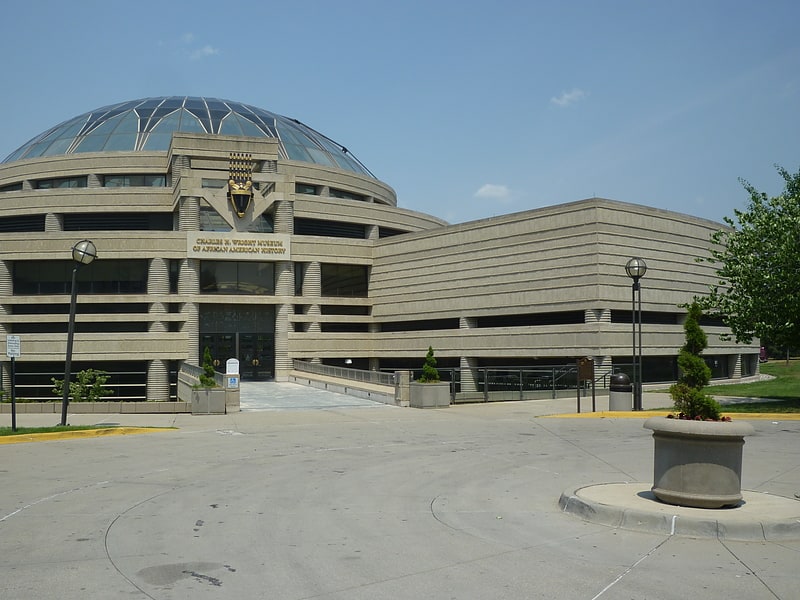
Museum in Detroit, Michigan. The Charles H. Wright Museum of African American History, or The Wright, is located in Detroit, Michigan in the U.S.; inside the city's Midtown Cultural Center is one of the world's oldest independent African American museums.
Founded in 1965, The Wright museum holds the world's largest permanent collection of African-American culture. With a collection of more than 35,000 artifacts, The Wright's current 125,000-square-foot museum opened as the largest museum in the world dedicated to African American history.
The Wright, whose exhibits include Underground Railroad documents and letters from Malcolm X and Rosa Parks, also hosted memorial events for Parks and the "Queen of Soul," Aretha Franklin, who lay in state in the museum's rotunda in 2005 and 2018, respectively.
Notably, The Wright is the current home of The National Museum of the Tuskegee Airmen The Wright also produces one of the largest festivals dedicated to celebrating the food, fashion, music, and dance cultures of the diaspora -- African World Festival.[23]
Address: 315 E Warren Ave, 48201 Detroit (Cass Corridor)
Dossin Great Lakes Museum
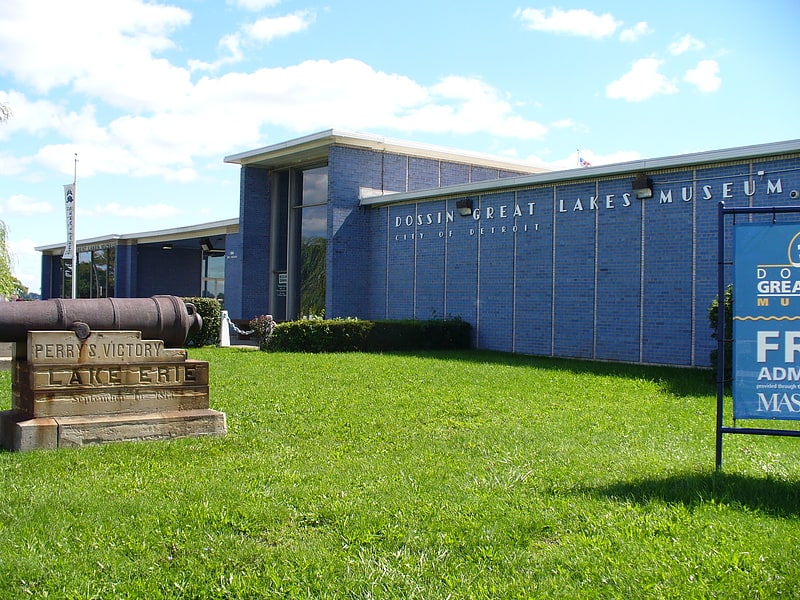
Museum in Detroit, Michigan. The Dossin Great Lakes Museum is an historical maritime museum in Detroit, Michigan. Located on The Strand on Belle Isle Park along the Detroit River, this museum places special interest on Detroit's role on national and regional maritime history. The 16,000-square-foot museum features exhibits such as one of the largest collection of model ships in the world, and the bow anchor of the SS Edmund Fitzgerald, which went down in a storm in 1975.[24]
Address: 100 The Strand, 48207 Detroit
Belle Isle Aquarium
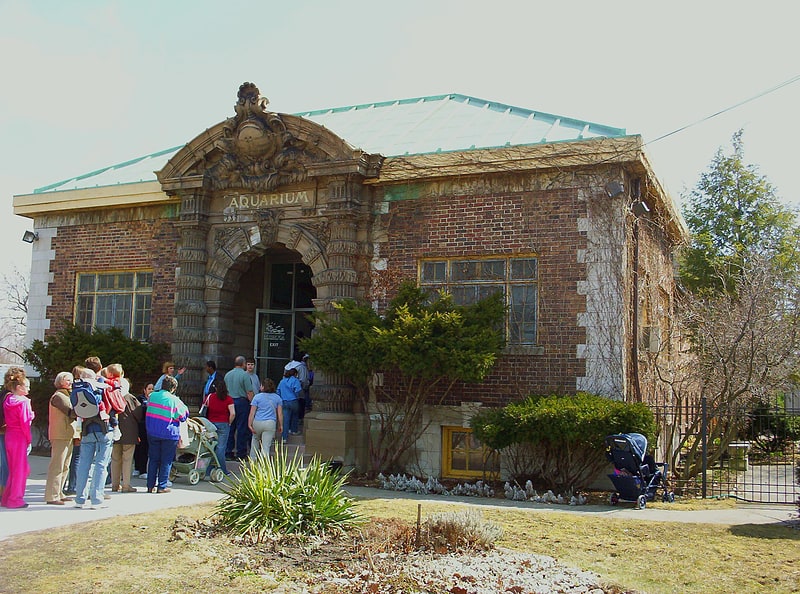
Historic attraction with many gar fish. The Belle Isle Aquarium is a public aquarium located in Belle Isle Park in Detroit, Michigan. Designed by noted architects George D. Mason and Albert Kahn, it opened on August 18, 1904, and was the oldest continually operating public aquarium in North America when it closed on April 3, 2005. The aquarium reopened to the public on August 18, 2012, and is now run entirely by volunteers. The 10,000-square-foot historic building features a single large gallery with an arched ceiling covered in green glass tile to evoke an underwater feeling.
The aquarium was operated by the Detroit Zoological Society prior to the 2005 closure. It is currently operated by the Belle Isle Conservancy.[25]
Address: 900 Inselruhe Avenue, 48207 Detroit
Belle Isle Conservatory
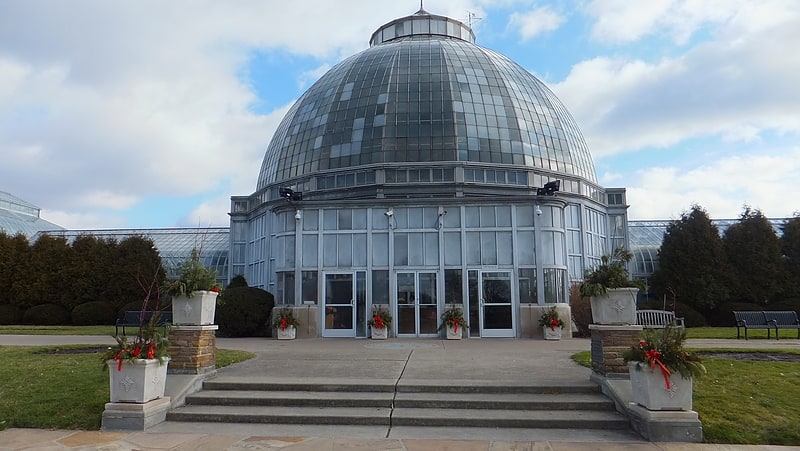
Tourist attraction in Detroit, Michigan. The Anna Scripps Whitcomb Conservatory is a greenhouse and a botanical garden located on Belle Isle, a 982-acre island park located on the Detroit River within Detroit, Michigan. While located near the Canada–United States border, the island is entirely within the U.S. The park itself consists of 13 acres of preserved land for the conservatory and its botanical garden.
Opened in 1904, the Anna Scripps Whitcomb Conservatory is the oldest continually-running conservatory in the United States. It is named for Anna Scripps Whitcomb, who left her collection of 600 orchids to Detroit in 1955.[26]
Address: Riverbank Dr., 48207 Detroit
Mariners' Church
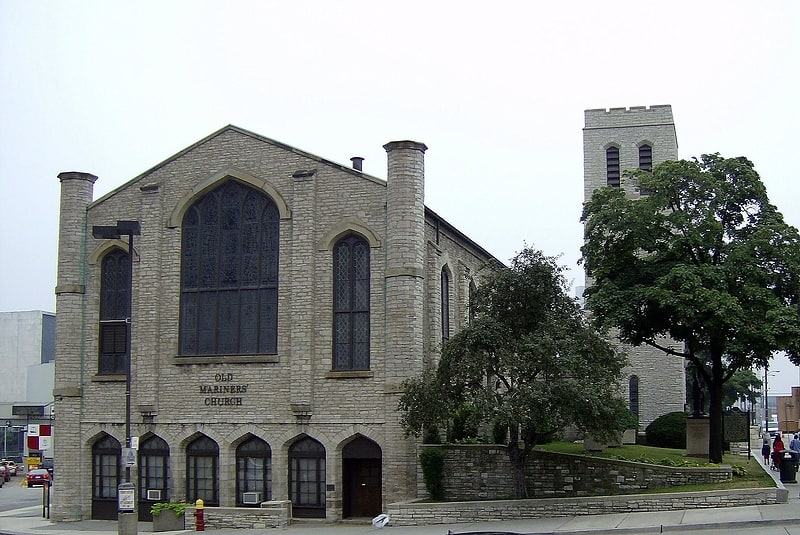
Anglican church in Detroit, Michigan. Mariners' Church of Detroit is a church with worship services adhering to Anglican liturgical traditions located at 170 East Jefferson Avenue in Downtown Detroit, Michigan. It was founded in 1842 as a special mission to the maritime travelers of the Great Lakes and functioned as a parish of the Episcopal Diocese of Michigan until 1992, when the Michigan Court of Appeals ruled it was incorporated as an independent congregation. The church was listed on the National Register of Historic Places in 1971. The church is now part of the REC Diocese of Mid-America within the Anglican Church in North America.
The church grounds contain a bronze sculpture of George Washington wearing the apron of a master mason by Donald De Lue. The sculpture is a copy of the wax original created in 1959 and was installed in 1966.[27]
Address: 170 E Jefferson Ave, 48226 Detroit
Saint Andrew's Hall
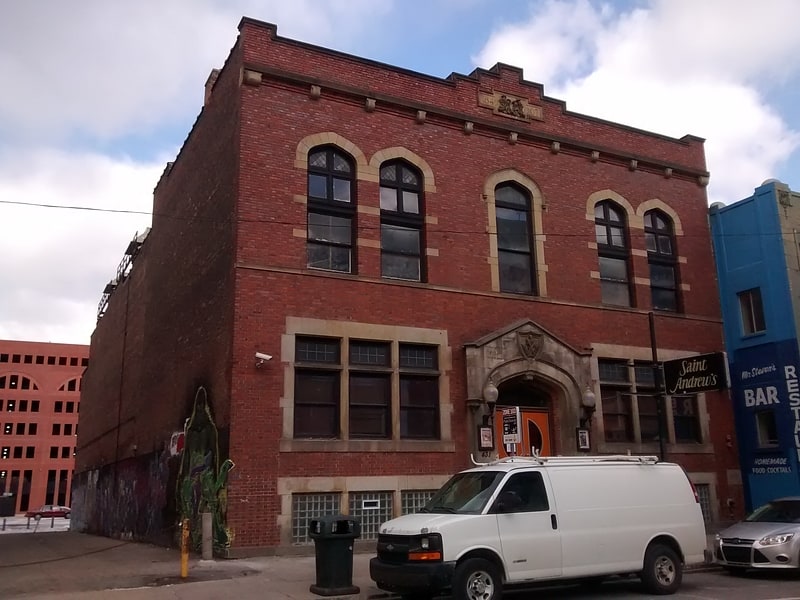
Concert venue in Detroit, Michigan. The Saint Andrew's Hall is a concert venue located in Detroit, Michigan. Formerly the meeting place for the Saint Andrew's Society of Detroit. The Shelter lies underneath St. Andrews Hall and hosts various live music acts and DJs. It is best known for being one of the first stages Eminem performed.[28]
Address: Detroit, 431 E Congress St, Detroit, MI 48226-2912
Cathedral of the Most Blessed Sacrament
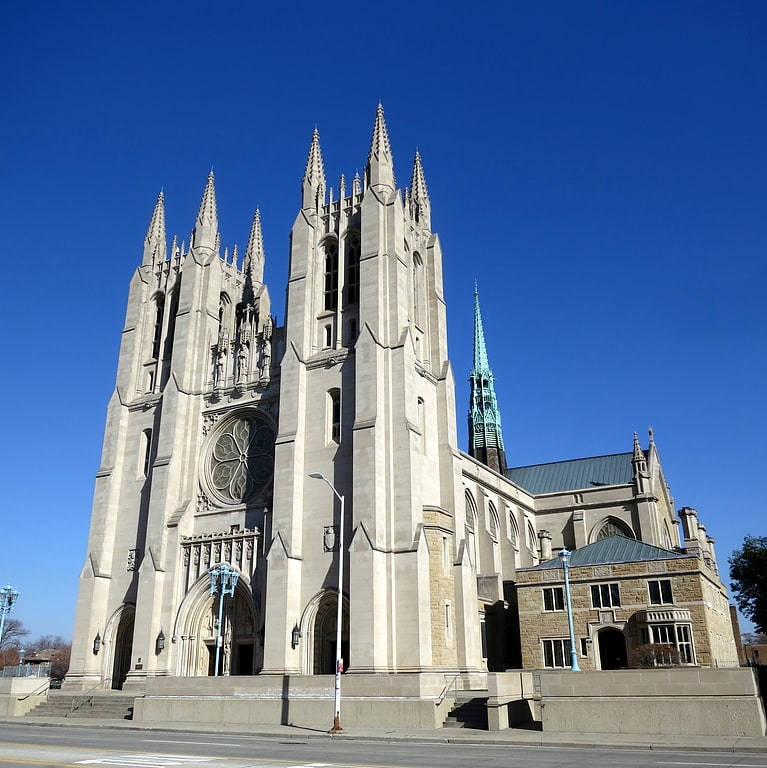
Cathedral in Detroit, Michigan. The Cathedral of the Most Blessed Sacrament is a Neo-Gothic style Roman Catholic cathedral church in the United States. It is the seat of the archbishop of the Roman Catholic Archdiocese of Detroit. The metropolitan archdiocese for the Roman Catholic Ecclesiastical Province of Detroit includes all dioceses in the state of Michigan; in addition, in 2000 the archdiocese accepted pastoral responsibility for the Roman Catholic Church in the Cayman Islands, which consists of Saint Ignatius Parish on Grand Cayman. The cathedral is located at 9844 Woodward Avenue in Detroit, Michigan, adjacent to Detroit's Boston-Edison Historic District. The cathedral was listed on the National Register of Historic Places in 1982.[29]
Address: 9844 Woodward Ave, 48202 Detroit (Central)
MGM Grand Detroit
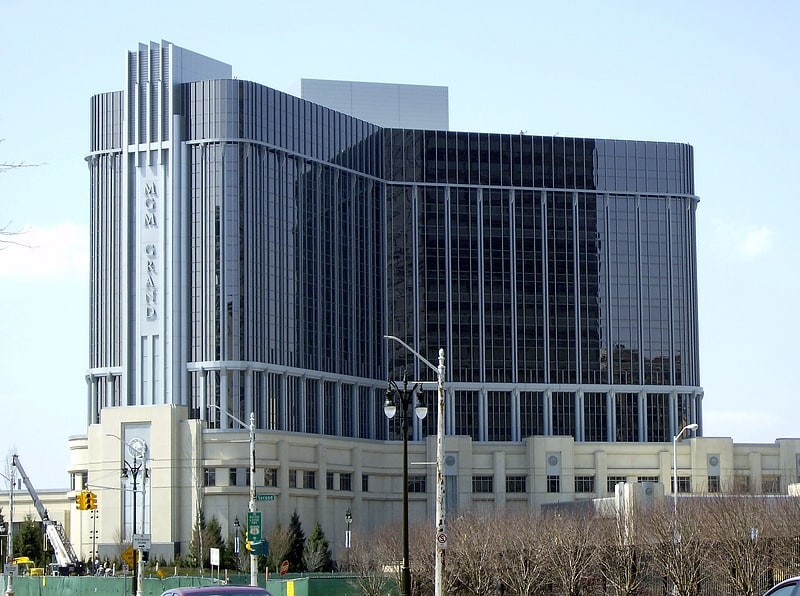
Hotel in Detroit, Michigan. The MGM Grand Detroit is one of three casino resort hotels in Detroit, Michigan, and one of four in the Detroit–Windsor area. The casino opened in its temporary location on July 29, 1999. The permanent, luxury resort hotel opened on October 3, 2007 with a grand event which included models and celebrities including Ashanti, Kid Rock, and fireworks. It is the first luxury casino resort hotel in a major metropolis outside Las Vegas.
Detroit is one of the largest American cities and metropolitan regions to offer casino resort hotels.[30]
Address: Detroit, 1777 Third Street, Detroit, Michigan 48226
Museum of Contemporary Art Detroit
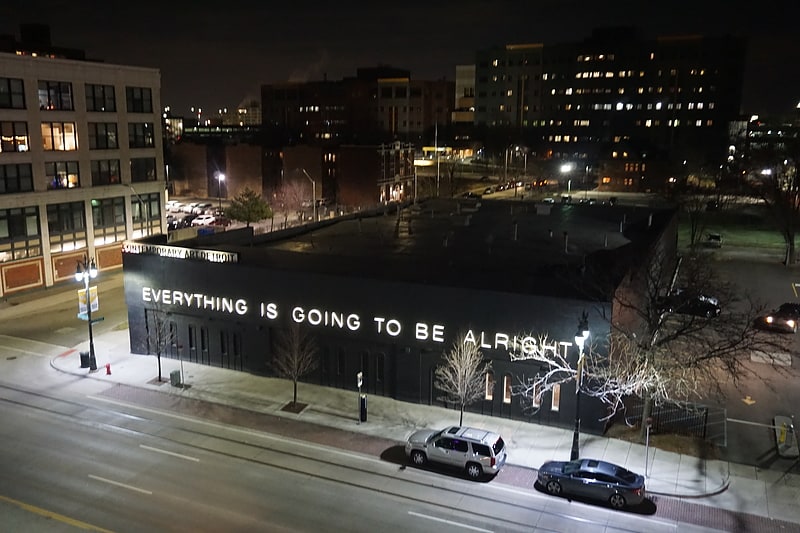
Art museum in Detroit, Michigan. The Museum of Contemporary Art Detroit is a non-collecting contemporary art museum located in Detroit.
MOCAD is housed in a 22,000-square-foot (2,000 m2) building, a converted former auto dealership designed by architect Andrew Zago. The architecture of the building was left intentionally raw and unfinished.[31]
Address: 4454 Woodward Ave, 48201 Detroit (Cass Corridor)
Masonic Temple
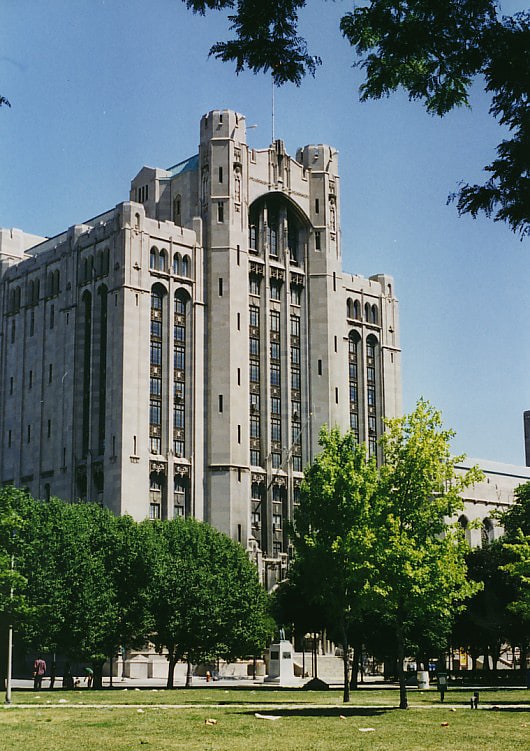
Huge space with historic 1920s design. The Detroit Masonic Temple is the world's largest Masonic Temple. Located in the Cass Corridor of Detroit, Michigan, at 500 Temple Street, the building serves as a home to various masonic organizations including the York Rite Sovereign College of North America. The building contains a variety of public spaces including three theaters, three ballrooms and banquet halls, and a 160 by 100 feet clear-span drill hall.
Recreational facilities include a swimming pool, handball court, gymnasium, bowling alley, and a pool hall. It is currently the home of the Detroit Handball Club. The building includes numerous lodge rooms, offices, and dining spaces, as well as a hotel section. Although the hotel rooms are available to any noble of the mystic shrine or blue lodge mason, none are currently in usable condition. Architect George D. Mason designed the whole structure as well as the Masonic Temple Theatre, a venue for concerts, Broadway shows, and other special events in the Detroit Theater District. It contains a 55-by-100-foot stage, one of the largest in the country.
The Detroit Masonic Temple was designed in the neo-gothic architectural style, using a great deal of limestone. The ritual building features 16 floors, stands 210 feet tall, with 1,037 rooms. It dominates the skyline in an area known as Cass Corridor, across Temple Street from Cass Park, and Cass Technical High School. It is within walking distance of the Little Caesars Arena and the MotorCity Casino Hotel.[32]
Address: Detroit, 500 Temple St, Detroit, MI
Detroit Historical Museum
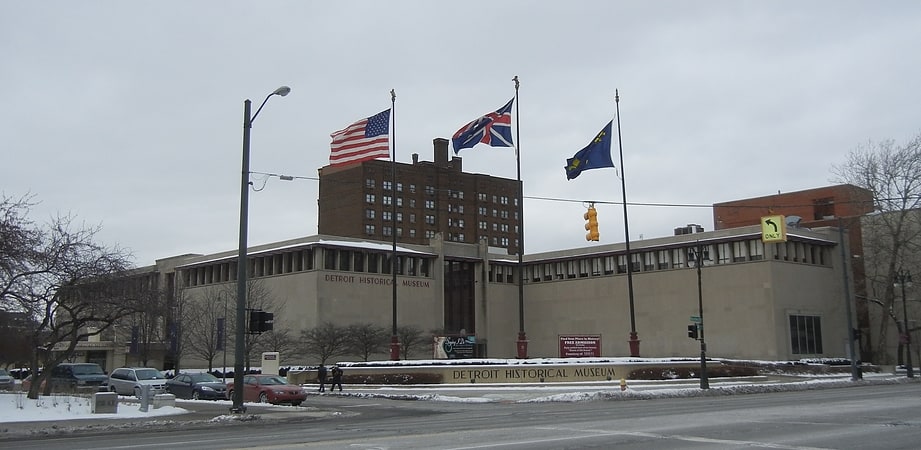
History museum in Detroit, Michigan. The Detroit Historical Museum is located at 5401 Woodward Avenue in the city's Cultural Center Historic District in Midtown Detroit. It chronicles the history of the Detroit area from cobblestone streets, 19th century stores, the auto assembly line, toy trains, fur trading from the 18th century, and much more.[33]
Address: 5401 Woodward Ave, 48202-4097 Detroit (Cass Corridor)
The Spirit of Detroit

Statue by Marshall Fredericks. The Spirit of Detroit is a monument with a large bronze statue created by Marshall Fredericks and located at the Coleman A. Young Municipal Center on Woodward Avenue in Detroit, Michigan.[34]
Heidelberg Project
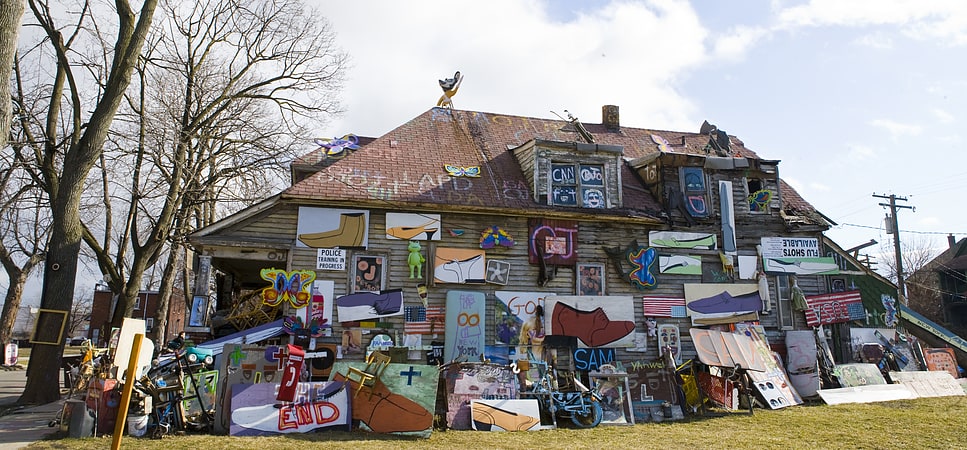
The Heidelberg Project is an outdoor art project in the McDougall-Hunt neighborhood on Detroit's east side, just north of the city's historically African-American Black Bottom area. It was created in 1986 by the artist Tyree Guyton, who was assisted by his wife, Karen, and grandfather Sam Mackey. The Heidelberg Project is in part a political protest, as Tyree Guyton's childhood neighborhood began to deteriorate after the 1967 riots. Guyton described coming back to Heidelberg Street after serving in the Army; he was astonished to see that the surrounding neighborhood looked as if "a bomb went off".
At first, the project consisted of his painting a series of houses on Detroit's Heidelberg Street with bright dots of many colors and attaching salvaged items to the houses. It was a constantly evolving work that transformed a hard-core inner city neighborhood where people were afraid to walk, even in daytime, into one in which neighbors took pride and where visitors were many and welcomed. Despite the area being characterized by high levels of blight and poverty, the evolving art work grew Tyree Guyton worked on the Heidelberg Project daily with the children on the block. He and director Jenenne Whitfield gave lectures and workshops on the project around the country. Their main goal was to develop the Heidelberg Project into the city's first indoor and outdoor museum, complete with an artists' colony, creative art center, community garden, amphitheater, and more. In 2005 the Heidelberg Project was awarded the Rudy Bruner Award for Urban Excellence silver medal.[35]
Address: 3680 Heidelberg St, 48207-2436 Detroit (Chene Park)